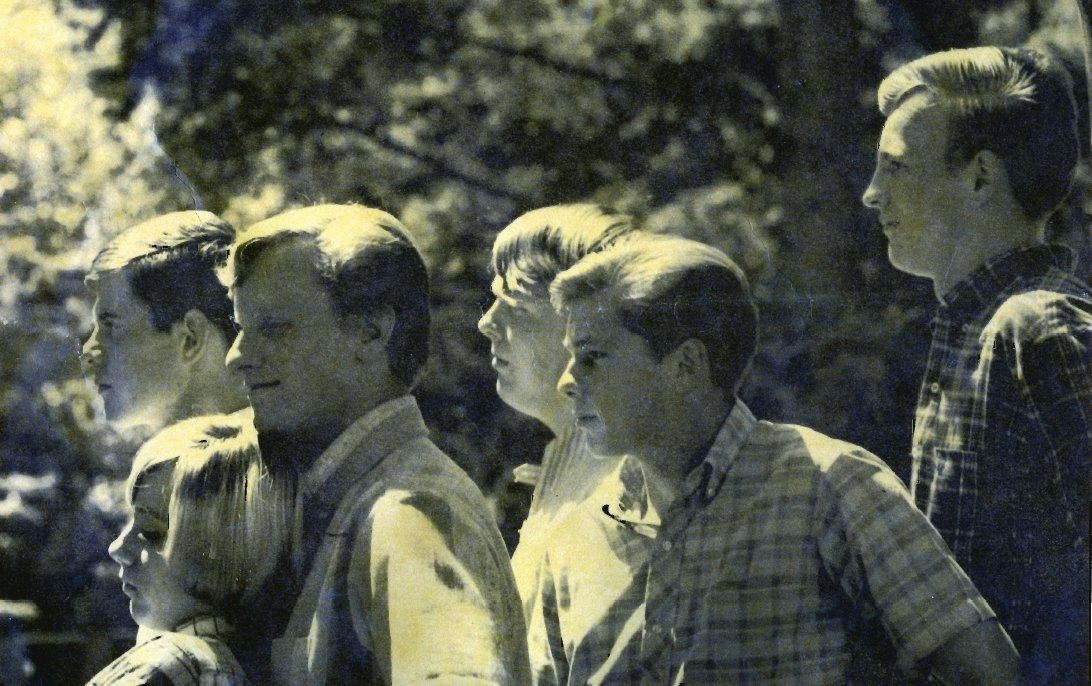
Becoming the Unusuals
The Unusuals evolved from five earlier 1960’s era Whatcom County rock ‘n’ roll bands. The beginnings trace back to a group called the Nite People. The Nite People became the Frantics, then the name was changed to the Accents. The Accents turned into Ron Petersen and the Accents and, when Petersen moved out of Bellingham in 1964, the band became the Bellingham Accents. In 1965, the Bellingham Accents were rechristened as the Unusuals – one of the quintessential Pacific NW garage bands in the sixties. This story is told by people who were there at the time. It will bring back many rock ‘n’ roll memories from 60 years ago.
The Nite People (1962-’63)

The Nite People got together in Bellingham in 1962, playing the regional teen dance hall circuit and at high school proms and dances. A radio ad, dating back to Nov. 15, 1962, promoted a dance featuring live music by the Nite People. KPUG nighttime deejay, T. Michael Forney, the voice heard on this radio spot, was enthusiastic about the Nite People and their “new rock sound.” This recording includes an authentic KPUG jingle from 1962.

Nite People spot with vintage KPUG Jingle (Running time :47)
Mike Forney’s commercial ran six weeks before Laurie Vitt, a Bellingham High School senior, joined the Nite People for the first time at a New Year’s Eve dance that ushered in 1963. The lineup that night included Gary Hill, a talented guitarist, vocalist and a student at Western (now Western Washington University). Hill had led his own group when he was a high school student and a basketball star in Napavine, WA. Other band members participating were Bellingham High School alums Reg Shannon on bass and Bill Cramer on drums. Laurie Vitt played tenor sax and there was a now unidentified keyboardist from Seattle, whose name has been forgotten all these years later. With 1960s rock ‘n’ roll bands, comprised of teenagers and students, personnel changes were inevitable and frequent.
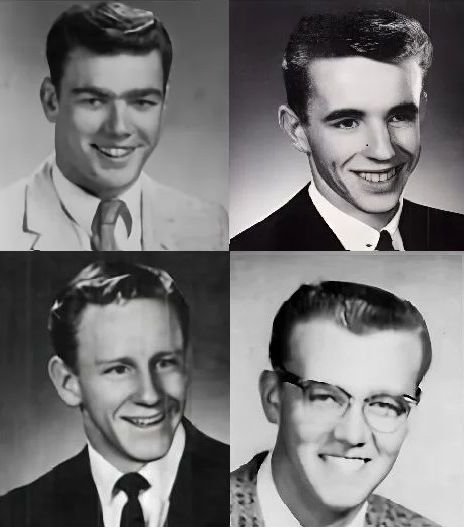
Vitt recalls, “Shortly after I joined the group, several changes took place: Bill Cramer departed and Pat Jerns from Bellingham became the drummer. When the keyboardist moved on, we hired Vic Bundy — a really young rock ‘n’ roll organist I knew from a band we’d both been in before.”

Ron Petersen Comes to Town (1963)
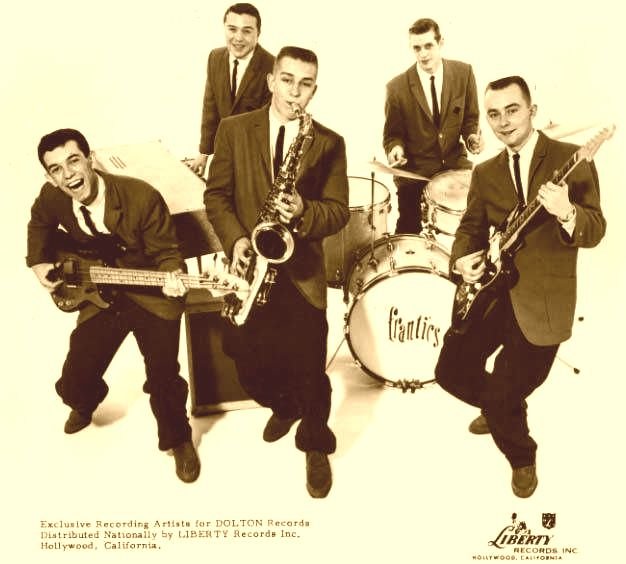
Ron Petersen, co-founder and ex-guitarist with the Seattle band the Frantics, moved to Bellingham in the fall of 1963 to attend college at Western. In the late 1950s and early ’60s, the Frantics were the most successful group in the state of Washington, releasing nine singles. Producing mainly instrumentals, three of their records — “Straight Flush,” “Fog Cutter,” and “Werewolf” — charted nationally on Billboard’s Hot 100. Success on the national stage was, and still is, a big accomplishment for a Pacific NW band.

After Petersen had settled in on Western’s campus, he got involved in Bellingham’s vibrant live music scene. Ron liked the Nite People’s music and, when guitarist Gary Hill moved away to further his career by playing professionally at casinos in Reno, Ron Petersen took his place. The photo below shows the Nite People shortly after Ron Petersen had joined the group in 1963.

Nite Moves


Ron Petersen was still new to the Nite People when quasi-leader of the group, Reg Shannon, announced that he’d trademarked the “Nite People” name. That gave him control over that name in the state of Washington. Not long after receiving his trademark, Shannon’s bandmates voted him out as their leader. They voted in Ron Petersen, the newest band member but the more experienced and industry savvy musician.
Pat Jerns remembers the ruckus that caused: “We respected Ron. Even in the months before he was the leader, he got our group into places we would not have seen otherwise. At one dance hall in Snohomish County he secured bookings for ten or twelve weeks in a row. Ron had the standing in the business to get what he wanted and he wanted us to be busy every weekend. After being demoted, Reg Shannon quit. As a parting shot, he told us that the Nite People name was his and he’d sue anyone who tried to use it. That left Ron Petersen in a bind. He needed to immediately rename his band and he needed to find a bass player to replace Shannon.”

Of Nite People and Night People
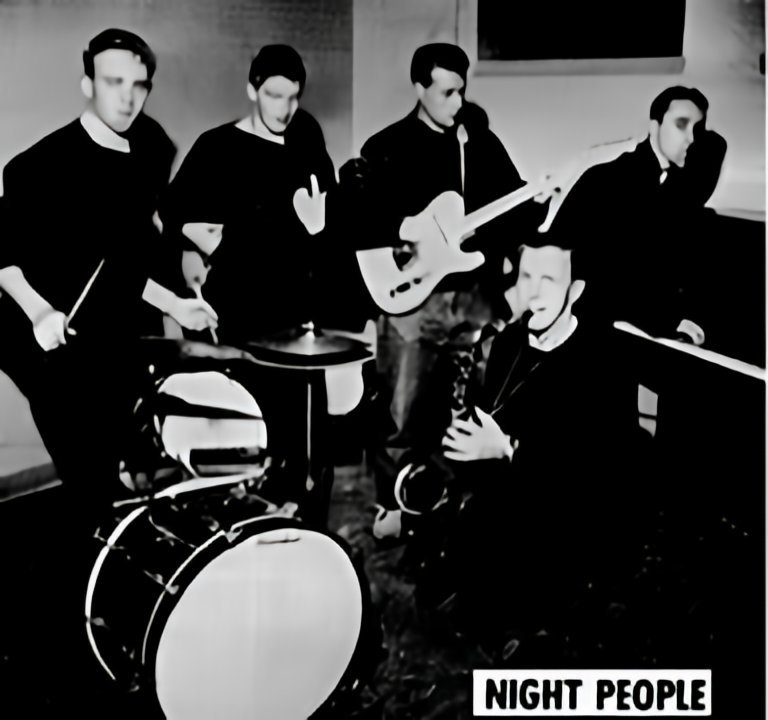

Historically, the “Nite People” have been confused with another band that had a nearly identical name. Compare the “Nite People” to the “Night People.” Different spellings, but the names sounded the same. The “Night People” came first, forming on Western’s campus in 1959. By year end 1959, they’d disbanded, moved to Seattle, and re-formed with a different lineup. In 1961, those first “Night People” recorded the single “Zazerac” b/w “Istanbul” on a Seattle record label.
The other “Nite People,” the group that would one day morph into the Unusuals, began in Bellingham circa 1962. The mix-up between the two different bands was bound to happen with the similar names, but there were other commonalities: Both groups had roots extending back to Western. And George Palmerton, who had been with the “Night People,” played bass for the former “Nite People” as the band transitioned to a new name after Reg Shannon’s turbulent exit. Note: Shannon’s trademark on the “Nite People” moniker, spelled in that manner, had no impact on the other “Night People” operating down Seattle way.
Frantics Revisited (1963)
After Reg Shannon’s sudden departure, Ron Petersen had to scramble to come up with a new bass player and another name for his band. He asked his talented friend George Palmerton to fill in on bass. And, in choosing a new name, Ron fell back on familiarity. He chose to call his band the Frantics. It made sense: He’d cofounded the original Frantics in Seattle and that group had dissolved at about the same time he’d moved to Bellingham.

Frantics to Accents (1963)

Unbeknownst to Petersen, another co-founder of the Frantics had reinvented his own incarnation of the Frantics. Chuck Schoning’s Frantics, based in Seattle, were already part of the teen dance circuit in the northwest and they were planning to release a single: “Blue Day” b/w “San Francisco Swim,” which would be forthcoming in the summer of 1964.
To circumvent any personal or legal spats, Petersen changed the name of his group to the Accents. That worked temporarily, but not for long. First, a band in Burien complained that they’d been known as the Accents since 1961. (In the summer of ’65, they released the single “I Want Your Love” and “All of My Life.”) Then, on the heels of that first complaint, musicians in British Columbia sent word that they too were doing business as the Accents. Laurie Vitt was there: “Seriously, we weren’t all that committed to the name the Accents. Our interest had to do with publicity. The Accents was kind of British sounding and, in the ’60s, any insinuation that a band might be from England drew positive attention and led to good press. When it became obvious that keeping the name would be a big hassle, instead of stressing over it, we just modified it to Ron Petersen and the Accents.”
Ron Petersen & the Accents (1963-’64) Cut a Record
In 1964, Ron Petersen and the Accents released their only single ”Linda Lu” b/w “Sticky.” The A side “Linda Lu,” lead vocal by Petersen and harmony by George Palmerton, didn’t chart nationally. But it received considerable airplay on top 40 radio in the Puget Sound region. The record generated lots of buzz and bookings. KJR’s popular deejay, Pat O’Day, who was the leading teen dance promoter in the state, was heard at the beginning of the recording introducing Petersen and the Accents. Click on the record below to listen to “Linda Lu” at the Unusuals’ YouTube channel. All of the YouTube videos presented here include vintage photos and memorabilia appropriate to the artists listed on the record labels. (Use the back arrow on your device to return to this article from YouTube.)
On the Sticky Side
Both sides of the single had momentum in the Pacific NW, largely because of airplay on KJR. Flip side “Sticky” was sax-heavy, and mostly an instrumental track, with songwriting credits going to two unidentified composers with the last names Davis and Brown. “Sticky” was catchy and it had been played on the radio enough that it became a familiar tune. At his YouTube channel, Tim Mills, a vintage 1960’s vinyl record collector in Seattle, remembered “Sticky”: “It was probably the most popular song by the group, it was a necessity to learn ‘Sticky’ if you were a northwest musician.”
Laurie Vitt, who played sax on the record, speculated that garage bands gravitated toward the “Sticky” side because “few local or teen bands had members who could have sung ‘Linda Lu.’ They couldn’t duplicate the harmony we had with Ron Petersen and George Palmerton singing together.” Click on the record below to listen to “Sticky” by Ron Petersen & the Accents. (Use the back arrow on your device to return to this article from YouTube.)
Interlude: Along Came Kathi

It was many memories ago, but Laurie Vitt remembers the first time he met female vocalist Kathi McDonald: “In late 1963 or early ’64, when Ron Petersen was leading the band, we’d been booked into a grange hall in Mount Vernon, WA. Before we went on stage, the guy in charge asked if this teenage girl he knew could sit-in for a couple of songs. Her name was Kathi. He said she was a good singer. Usually we didn’t allow sit-ins, but we agreed to it that time. When we were introduced to her, there stood a short, very skinny, school girl with stringy blond hair. Kathi was 14 years old, or maybe she’d just turned 15. She looked nothing like a singer. Our first impression was so-so. We asked what songs she knew and she rattled off the titles of a few of the very old Ike and Tina Turner records. The first song we played was “It’s Gonna Work Out Fine,” and Kathi’s voice blew us off the stage. She was phenomenal. It was like having Tina Turner in the room. We were beyond impressed! When Kathi was on stage she was a natural talent with total command of the audience. After her amazing impromptu debut at the grange hall, we were all sold on Kathi McDonald. Afterwards, she asked if she could sing with our band. Ron said ‘sure, she could sing with us,’ but since she wasn’t really part of the group she wouldn’t get paid. That changed later on as Kathi matured and her voice attracted lots of attention.”
Bellingham Accents (1964-1965)

Lineup changes in Ron Petersen and the Accents began when Ron’s friend George Palmerton grew tired of commuting to Bellingham from his home in Seattle. Palmerton was replaced by Doug Ling. However, the most consequential change took place in the summer of ’64. That’s when Ron Petersen graduated from Western and accepted a position teaching music in a small school district near Centralia (the town of Winlock, WA). Bill Capp, a local musician who played a mean lead guitar, took Petersen’s place. Then the name was changed from Ron Petersen and the Accents to the Bellingham Accents. Next, as it turned out, bassist Doug Ling didn’t stick around for very long. He moved on and Harvey Redmond joined the band. Capp and Redmond would both be key players in the Unusuals.

Bacon Fat
In 1964, the Bellingham Accents released their only single, “Bacon Fat” b/w the instrumental “Sampan.” Laurie Vitt played tenor sax and took the lead vocal on the A-side. The lyrics suggest there was at one time a dance called the Bacon Fat, but any remnants of such a dance seem to have been lost to time. “Bacon Fat,” while not original to the northwest, was recorded (with altered lyrics) by the Tacoma group the Viceroys. The biggest hit of “Bacon Fat” dated back to 1957 when Detroit soul singer Andre Williams, who wrote the song, took it top 10 on Billboard’s R&B chart. The novelty tune had remarkable staying power: In 1978, the Manhattan Transfer covered “Bacon Fat” on a live album. Click on the record below to listen to “Bacon Fat” by the Bellingham Accents. (Use the back arrow on your device to return to this article.)
The flip side was the instrumental “Sampan,” written by several of the Unusuals, and featuring Laurie Vitt on tenor sax. Click HERE to listen to the record. (Use the back arrow on your device to return to this article.)
The Unusuals (1965-1967)
The band that began as the Nite People and morphed into the Frantics, then the Accents, followed by Ron Petersen and the Accents and then the Bellingham Accents, became the Unusuals in the summer of 1965. The original lineup consisted of Kathi McDonald (vocals), Laurie Vitt (12 string guitar, rhythm guitar, vocals and tenor sax), Bill Capp (lead guitar, vocals), Harvey Redmond (bass, vocals), Vic Bundy (organ, backing vocals) and Pat Jerns (drums).

How That Unusual Name Came To Be

The Unusuals were accompanied on stage by a snake, a boa constrictor billed as six to 10 feet long (it grew as it matured). Snake handler Laurie Vitt said the serpent wasn’t dangerous, at least not until it grew to about 12 feet. That rock ‘n’ roll boa made the Unusuals memorable and it’s one reason the band got its name. Pat Jerns tells the story:

“I was the drummer and the bookings/business manager for the Bellingham Accents. In summer ’65, I got a call from Terry Bassett, an executive representing Pat O’Day and Associates. O’Day was a radio DJ who organized and promoted teen dances, battles of the bands, teen fairs and concerts. Later Bassett and O’Day founded Concert’s West — a big time concert promotions company that operated nationally. Bassett had connections in Bellingham and Whatcom County. He opened the Village West dance hall at Birch Bay in 1965. But when he called me, I knew him only because he had booked us a few times. Bassett needed my help. He was promoting a regional act: Dewey Martin, a pop singer and drummer who went by the pseudonyms Sir Walter Raleigh or Sir Raleigh. Raleigh and his band the Coupons, or the Cupons (spellings varied), worked hard to create the impression they were from England. They sported Beatle haircuts and wore British suits. Nonetheless, it was all an illusion: Raleigh was a Canadian. But, true to his British theme, one of his first singles in the ’60s was a remake of the old British WWII song ‘The White Cliffs of Dover.’

“Bassett had a big problem: The Coupons had quit, or maybe Raleigh had fired them. He could be impetuous. Anyway, Bassett needed a replacement backing band for Raleigh and he wanted that band to be the Bellingham Accents. However, there was a catch. It was an era of groups with strange names like Sam the Sham & the Pharaohs, Question Mark and the Mysterians, the Guess Who, the Yardbirds, the Zombies, the Lovin’ Spoonful and so on. Bassett said he wanted the Bellingham Accents to come up with a new name. I said we’d be interested in the gig, but I needed to think about the name change. I found out that trying to achieve consensus on a new name, among six band members, was a monumental pain — like naming a child. We talked the subject to death and finally put it on the back burner.
“A week later, Bassett called again. He was ready to print flyers and posters for Raleigh’s tour and he asked me about our new name. I told him we were still struggling with that detail and we had yet to rename the band. He responded that post-haste we needed to settle on an ‘unusual’ name so he could take it to the printer. When he worded it that way, it was an instant bingo. I said, ‘Terry, that’s our new name. We will call ourselves the ‘Unusuals.’ Bassett liked it and the name fit. We were unusual. Our lead singer was a tiny waif of a girl with a giant voice and we appeared on stage with a big snake. Shortly after, when I shared our new name with my bandmates, fortunately everybody liked it. The name the Unusuals stuck, enduring from 1965 until the group broke up in 1967.”

Memories of Sir Raleigh

While Jerns, Vitt and the other Unusuals were not fans of traveling with Sir Raleigh, Vitt does recall an upside: “Usually we played at teen dances and proms. The tour with Raleigh got us on stage with bigger name northwest acts like Ian Whitcomb, Don & the Goodtimes, the Fabulous Wailers and the Sonics. In summer 1965, we had the opportunity to open for British Invasion notables Herman’s Hermits and Wayne Fontana and the Mindbenders. We felt like rock stars performing in front of 16,000 screaming fans at the Seattle Center Coliseum.”
Top 40 radio listeners of the era will remember that the Hermits were huge in 1965: Top 10 hits with “Mrs. Brown You’ve Got a Lovely Daughter,” “Can’t You Hear My Heartbeat,” and “I’m Henry VIII, I Am.” The latter was Number One in the U.S.A. in the summer of ’65 as seen on this KOL radio TuneDex survey with Sir Raleigh’s photo at the bottom. Pat Jerns recalled the tour: “We did about 28 shows spread from July into August 1965. That was all we could take of Raleigh. He was difficult to deal with, a real egotist. The Herman’s Hermits’ show led to the most fun I ever had playing music, and it doubled as the most stressful night I ever had playing music. At Seattle Center Coliseum, we were one of several rock groups and the not so famous drummers, including me, shared a communal drum set. When the Unusuals took the stage, all the kids were screaming their heads off. In the excitement, I almost immediately blew out the head on the loaner snare drum. A replacement wasn’t in the offing, and a snare drum was important to our sound, so I covered as best as I could by beating on the ride tom (small drum attached to the bass drum). Luckily it was a short set and I don’t know if anyone, other than those of us in the band, knew that something had gone awry. But it was agonizing for me and I’ll never forget that night.”
Buffalo Springfield & Dewey
Sir Raleigh became a star in 1966, about a year after his tour with the Unusuals. Raleigh gained fame under his real name, Dewey Martin, versus his showbiz alias. He became the drummer in the iconic folk rock band Buffalo Springfield (“For What It’s Worth,” “Bluebird” and “Mr. Soul”). Thirty years after their mid-’60s chart success, Martin and other members of Buffalo Springfield: Neil Young, Bruce Palmer, Stephen Stills and Richie Furay were inducted into the Rock and Roll Hall of Fame in Cleveland. Martin, Young and Palmer were Canadians. Stills and Furay were Americans.

Snakes Alive
The rock n’ roll boa was one of Laurie Vitt‘s many reptiles. Vitt began collecting snakes, and handling the venomous kind, when he was nine years old. As a youth, Laurie’s bedroom was cohabitated by snakes. In autumn 1965, the Western Collegian student newspaper wrote: “He brings his pet boa constrictor, Herky, to the dances. Both he and Miss McDonald [Kathi McDonald] handle the seven-foot serpent, which dines monthly mostly on rats, baby chickens and whatever else he can swallow. Vitt the tenor sax and 12 string guitar player for the group [the Unusuals] is a 21-year-old biology major at Western.”
The ever present boa constrictor made the Unusuals standout among their peers who were working the teen dance circuit. In 1965, Lan Roberts, a deejay at KJR-Seattle, played up the boa in a radio ad for the Target Ballroom in Burien. Click below to hear the radio spot. (It’s hosted at this website, so there is no need to use the back arrow to return to the article.)
Lan Roberts and the Boa (Running time :51)
Time of the Snake
In Feb. 1965, Time Magazine published Hobbies: Unloading the Ark. In the story, Laurie Vitt’s interest in serpents and other creepy crawlies received national attention: “Snake-fancying sophomore Laurie Vitt of Western Washington State College has a python, rattlesnake, tokay gecko and two boas, which he keeps in his room with his tarantulas when his parents entertain.”

Pat Jerns met many of Laurie’s snakes: “When we stayed overnight in Eastern Washington, Laurie got up early and headed to the desert to catch rattlesnakes. The rattlers usually rode back to Bellingham in a pillow case on the floor in the back of my car. Kathi was nervous about the snakes, afraid they’d get loose. We told her not to worry about it and, lucky for us, none of them ever got out of the bag. We traveled to our gigs in a 1957 black Cadillac limo, towing behind it a trailer full of amps and equipment. My dad was in the funeral business. When I wanted a big car, he sent me to a used car dealer in Portland who sold good condition, low mileage limos and hearses. I bought the car for $600 and the band reimbursed me 10 cents a mile for gas and something towards upkeep. That’s back when gas cost less than 50 cents a gallon.”

Different Stripes for Different Folks

Laurie Vitt’s boa constrictor stirred different reactions in different people. “It took some persuasion before Kathi was willing to touch the snake,” Vitt recalls, “but she got comfortable enough around him that we would walk on stage with Herky wrapped around us. Sir Raleigh was not into the boa. Scared, he refused to come anywhere near it. On the other hand, when they were backstage, the British guys in Herman’s Hermits and Wayne Fontana and the Mindbenders really liked meeting the snake.”
Snakes were only one of Laurie Vitt’s interests. Musicianship also ran in his family. Older brother, Bill Vitt Jr., developed into a world class drummer who recorded with Jerry Garcia and other major stars. Laurie’s father, Bill Vitt, was a junior high school math teacher. In the mid-’60s, he founded the Bill Vitt Quartet. His group was comprised mostly of school teachers and Bill played sax and electric piano. Ron Petersen, Laurie’s former bandmate and later a music teacher, sometimes commuted to Bellingham to perform with the Bill Vitt Quartet. For 25 years, Bill Vitt’s Quartet played dances at the Bellingham Yacht Club, the Elks Lodge and other popular venues in the Pacific NW.

Babe, It’s Me
The Unusuals’ first single, “Babe, It’s Me” b/w “I’m Walking, Babe” was recorded in 1965 and released in spring 1966. The song was big in Bellingham and a modest hit in some other cities. The duet featured Laurie Vitt and Kathi McDonald singing back and forth lyrics. “I had Sonny and Cher’s ‘I Got You Babe’ in mind when I wrote it,” Vitt recalled. The recording was engineered by Kearney Barton, a Seattle studio engineer who is often referred to as “the architect of the Northwest sound.”
The record didn’t receive much airplay in Seattle. Unfortunately for the Unusuals, Pat O’Day at KJR was focusing on promoting the Fabulous Wailers and the Sonics — Seattle area rock groups that were important to the success of his own lucrative teen dance business. Click on the record below to listen to “Babe, It’s Me” at the Unusuals’ YouTube channel. (Use the back arrow on your device to return to this article.)
Wilde Times (1966)

The similarity between “Babe it’s Me” and Sonny and Cher’s distinctive style didn’t go unnoticed at KPUG in Bellingham. Music director Kirk Wilde said on-air: “Kathi and Laurie remind me of Sonny and Cher, except Laurie can sing and Sonny can’t.” Years later, Wilde elaborated: “I really liked “Babe It’s Me” and I put it in rotation. There was a big response from listeners and local record retailers reported brisk sales. For four or five weeks in spring of ‘66, it held steady at the top of our KPUG Sound-Hit Survey of the 50 most popular songs. ‘Babe, it’s Me’ knocked ‘(You’re My) Soul and Inspiration,’ by the Righteous Brothers, out of the Number One slot. A few other artists on that chart were the Beatles, the Rolling Stones, the Dave Clark Five, Bob Dylan, Johnny Rivers, Cher, the Beach Boys, the Young Rascals, the Lovin’ Spoonful, Simon and Garfunkel, Paul Revere & the Raiders, Herman’s Hermits, the Yardbirds and the Mamas and the Papas.”
For five decades, Wilde saved a copy of one of those surveys that had the Unusuals topping the chart. It provides an interesting and nostalgic snapshot back in time.

Unusually Popular
In April 1966, the Western Collegian reported: “The Unusuals, a rock and roll band, really is unusual, and unusually popular too. Since recording their hit, “Babe It’s Me” the Unusuals have rapidly been gaining fame. When asked about the song, which he wrote, Laurie Vitt said, ‘I was just driving down the street and all of a sudden it hit me, so I went home and wrote it.’ The group, which became the ‘Unusuals’ less than a year ago, has played with such groups as Herman’s Hermits, Don & the Goodtimes and Ian Whitcomb. They have played extensively on the West Coast and hope to be engaged in San Francisco soon for another recording session [“Summer Is Over” b/w “I Could Go On”].”
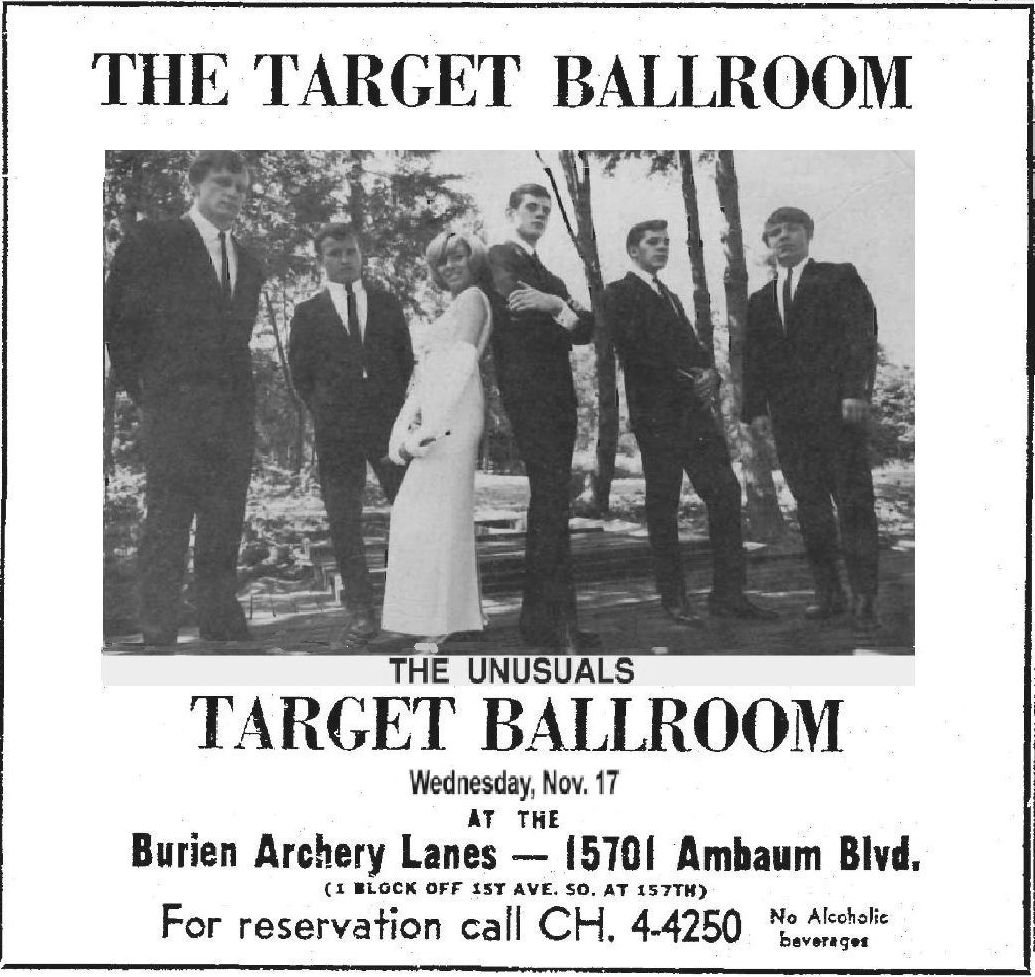
I’m Walking, Babe


The flip side of “Babe, It’s Me” was titled “I’m Walking, Babe.” The lead vocal highlighted the Unusuals’ bass player Harvey Redmond. Written by Jay Hamilton, a musician, a songwriter and a deejay at KPUG in the ’60s, “I’m Walking, Babe” was a radio hit in Eugene, OR and in a few other cities. All these years later, “I’m Walking, Babe“ has become the most sought after side. Categorized as a garage band classic, and coveted by collectors of rare records, the current cost of a vinyl copy of the Unusuals’ first single stands at about $1000 (the high price driven by the “I’m Walking, Babe” side). The track has made it onto numerous garage band compilation albums and “I’m Walking, Babe” has been covered by musicians in the U.S. and Europe. Two European TV series have incorporated the Unusuals’ single into their soundtracks and themes.
Jay Hamilton has given considerable thought to what factors turned the tune he wrote 60 years ago into a garage band classic: “My current conclusion is threefold. First, the song itself with its simple and universal themes of teen angst, young love and passion created some difference. But to be honest and more importantly, I’m of the opinion that most of the credit lies with the group: the Unusuals themselves. Their musical interpretation of my song made it into the ‘garage classic’ it became. So, the second reason is without a doubt the frantic angst-filled vocals by Harvey Redmond. The third reason rests with the terrifically imaginative guitar lead by Bill Capp. I can’t tell you how many reviews I’ve read comparing “Walking” to the sounds of Jim Morrison & the Doors, who didn’t burst upon the music scene until several years later. In short, it was what the Unusuals created with the song that managed to give it that ‘special something’ which garage music fans and bands alike listen for and collectively relate to.”
Many variations of Jay’s composition can be found at YouTube. The benchmark, of course, is by the Unusuals. Click on the record below to listen to “I’m Walking, Babe” at the Unusuals’ YouTube channel. (Use the back arrow on your device to return to this article.)
That’s Life!
 The Unusuals probably reigned as Bellingham’s all time highest profile band until the 1980s. That’s when the Posies came along. Then, in the late 1990s, the now famous Death Cab for Cutie got started in Bellingham. But, back in 1965, the Unusuals were on the cusp of achieving international exposure after a freelance writer for Life Magazine took an interest in the musical group. “The magazine sent photographers on the road with us,” Laurie Vitt reminisced, “and truth be told the woman writing the article was the first person to convince Kathi that it would make a great publicity picture if she would hold the snake. Kathi didn’t want to, but she reluctantly agreed to give it a try for the sake of the magazine article. Kathi seemingly decided it wasn’t so bad after all and, from that point forward, she wasn’t timid about holding the boa when we appeared on stage.”
The Unusuals probably reigned as Bellingham’s all time highest profile band until the 1980s. That’s when the Posies came along. Then, in the late 1990s, the now famous Death Cab for Cutie got started in Bellingham. But, back in 1965, the Unusuals were on the cusp of achieving international exposure after a freelance writer for Life Magazine took an interest in the musical group. “The magazine sent photographers on the road with us,” Laurie Vitt reminisced, “and truth be told the woman writing the article was the first person to convince Kathi that it would make a great publicity picture if she would hold the snake. Kathi didn’t want to, but she reluctantly agreed to give it a try for the sake of the magazine article. Kathi seemingly decided it wasn’t so bad after all and, from that point forward, she wasn’t timid about holding the boa when we appeared on stage.”
The editors at Life even confirmed the story would run in the Nov. 19, 1965 issue. The Unusuals would grace the front cover. Then everything went topsy-turvy. The Big NE Power Blackout of 1965 hit on Nov. 9th. National coverage of that unexpected crisis bumped the Unusuals right out of the pages of Life Magazine.
Change Was in the Air
Pat Jerns, the drummer, was the first to exit the Unusuals. Early on in 1966, he took a job as the manager of the Village West dance hall at Birch Bay (owned by the previously referenced Terry Bassett). Gary Ramsey took over as the drummer. Raised in Las Vegas, after a stint in the U.S. Navy and duty in Vietnam, Ramsey was assigned to the Whidbey Island Naval Air Station at Oak Harbor. Completing his service, Ramsey moved to Bellingham where he managed a downtown steak house. Active on the local music scene, and known to be a good drummer (he’d played in Vegas casinos in his youth), Ramsey was recruited by the Unusuals. We only know of one photo of Gary Ramsey with the Unusuals. It was printed circa 1966 as part of a promotional flyer for the band.

Summer Is Over
The Unusuals released a second single: “Summer Is Over” was the A-side with “I Could Go On” as the flip side. Kathi McDonald took the lead vocals on both sides. Recorded in San Francisco in the summer of 1966, the single was released for radio play that fall. Record World, a national publication that catered to the broadcasting and music industries, gave the song a solid four star rating (below).
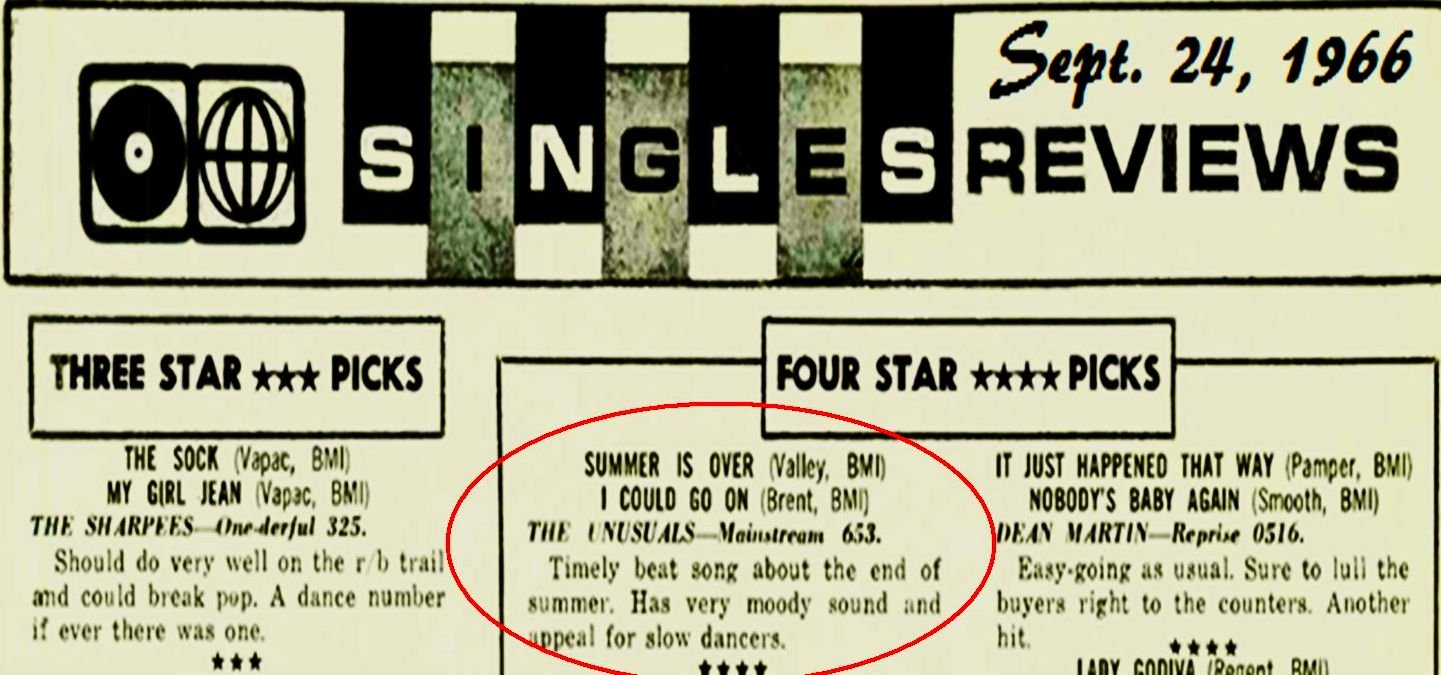
In Britain, “Summer Is Over“ had been an underperforming 1964 single by Dusty Springfield (Tom Springfield, Dusty’s brother, co-wrote the song with Clive Westlake). The Unusuals’ cover was released two years later. The record reached the top 10 — but never Number One — at KPUG in Bellingham. “Summer Is Over” was also a hit at a radio station in Great Falls, MT. Gary Ramsey, the band’s newest member, was the drummer at that recording session. Click on the record below to listen to “Summer Is Over” at the Unusuals’ YouTube channel. (Use the back arrow on your device to return to this article from YouTube.)
The flip side of “Summer Is Over” featured “I Could Go On,” another vocal by Kathi and a song written by Bill Capp of the Unusuals. Listen to it HERE. (Use the back arrow on your device to return to this article from YouTube.)
In a 2005 radio interview with an Australian broadcaster, Kathi talked about her life as a singer, the early years with the Unusuals, and she described the “Summer is Over” recording session in San Francisco. Click on Kathi’s photo below to listen to her interview at YouTube. It is accompanied by nostalgic photos and videos of Kathi. (Use the back arrow on your device to return to this article.)
Kathi Up Front and Center
Kathi McDonald’s powerful live performances and her obvious vocal talents on “Babe, It’s Me” and “Summer Is Over” led to regional acclaim. She gained many fans in the northwest and, prior to the Unusuals disbanding in mid-1967, Kathi sometimes received top billing in the group’s promotional advertising.

Acid Tests and Other Ordeals

By coincidence perhaps, the Unusuals drifted apart after Jefferson Airplane appeared at Western’s Carver Gym on May 26, 1967. Everything aligned to make that show a cosmic counterculture event. In sequence, three months prior to the concert, Dr. Timothy Leary visited Western espousing the benefits of LSD and “tuning in, turning on and dropping out.” The day before the Airplane concert, beat poet Allen Ginsberg arrived on campus to offer a poetry reading for Western students. Anticipation reached pandemonium when pop culture icon, author and hipster-savant Ken Kesey (“One Flew Over the Cuckoo’s Nest”) and his merry pranksters rolled onto the campus in a psychedelic bus. (Ginsberg and Kesey would both attend the concert.) The rumor around Bellingham was that Kesey had stowed away on his bus an ample supply of LSD to share with Western students.

With a “hippie” invasion arriving at Bellingham’s doorstep, and visions of rampant drug abuse alarming the mostly non-hip citizenry, the president of Western offered a concession to appease the city. He forbade the use of flashing psychedelic strobe lights during the concert. That order was mostly ignored by the stagehands. A Bellingham concert goer, who was 15 years old at the time, said that the only thing he remembers about the Airplane show at Western was the flashing strobe lights. A “near riot” is how the event was described by the Western Collegian: Student reporters claimed that security crews lost control of the 2000 concert attendees and, contrary to standard fire and safety decorum, the crowd refused to stop dancing in the aisles at the packed to the gunnels Sam Carver Gym.

The Safety Patrol, a short-lived band later called Fat Jack, opened for the Airplane. Intrigued by the new psychedelic music, which was not part of the Unusuals’ standard repertoire, Kathi McDonald sometimes sang part-time with Safety Patrol as an outlet for musical experimentation. She was the lead vocalist for Safety Patrol the night Jefferson Airplane performed at Western. The Unusuals’ drummer, Gary Ramsey, also sat-in with Safety Patrol because their regular drummer was too inexperienced to perform at a big event. For weeks preceding the concert, ads for the psychedelic extravaganza ran on local radio and in the Western Collegian.

In June 1967, the Collegian praised Kathi McDonald and the recent concert: “Safety Patrol although billed second, was surpassed by the Airplane only in their more professional stage manner and they are, by the Airplane’s own admission, one of the finest groups on the west coast. Kathi McDonald’s voice, Bruce Kirkman’s lyrics and Jack Hansen’s guitar playing [Kirkman and Hansen were both members of Safety Patrol] form an unbeatable combination.”
Unusuals Unraveling
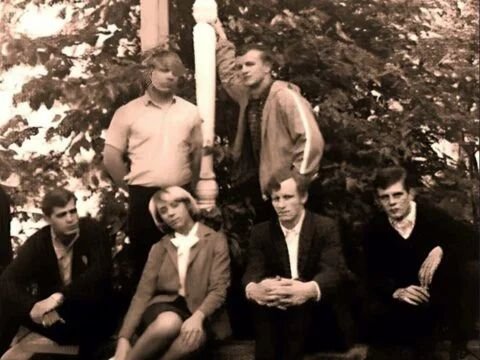

Not long after the Jefferson Airplane show, Kathi McDonald headed for the Haight-Ashbury district in San Francisco. Then Gary Ramsey relocated to San Francisco to pursue his own musical interests and to pal around with Kathi and her friends. One of her friends was the now famous backup singer Claudia Lennear (inspiration for Mick Jagger’s “Brown Sugar”). That summer, the Unusuals’ bass player Harvey Redmond graduated from Western with a degree in music. He accepted a teaching position in SW Washington near Longview. Piece by piece the Unusuals were unraveling: With the departure of Pat Jerns in 1966, followed by Kathi, Ramsey and Redmond in the spring and summer of ’67, only Laurie Vitt, Bill Capp and Vic Bundy remained with the band. Half of the group was gone. The original Unusuals, Bellingham’s premier mid-’60s rock band, would never reunite nor would they ever perform together again.
Later Generation Unusuals (Fall 1967- Late 1970)
Two hybrid groups kept the Unusuals’ name alive into the 1970s. The second-generation Unusuals, which formed shortly after the original Unusuals disbanded, was a three-piece bar band with Laurie Vitt on guitar and singing, Gary Ramsey (who’d returned from his hiatus to California) was on drums, and new recruit Terry Allan played the bass. The third-generation band had original members Laurie Vitt on rhythm guitar and Bill Capp on lead guitar. Laurie and Bill both sang. Mick Murray was on bass with Rob Rideout on drums. That completed the foursome. The group regularly played at the Up & Up Tavern and the Iron Bull in Bellingham with weekend forays to the Reef at Point Roberts. Original organist for the Unusuals, Vic Bundy, occasionally sat-in when they played at the Reef. In 1970, the band’s name was changed from the Unusuals to David. At the end of ’70, Laurie Vitt relocated to Arizona to pursue a doctorate degree. His departure also marked the end of the Unusuals. Any remaining memories of the band now linger on mainly at Facebook and YouTube or in the hearts and minds of those of us who were lucky enough to have been there at the time.

Epilogue

Even though they went their separate ways and followed different and divergent career paths, none of the Unusuals ever left the music behind. It remained a vital part of all of their lives.
*Kathi McDonald earned her chops as a blues and rock singer performing and recording with name entertainers: Ike & Tina Turner, Big Brother and the Holding Company, Joe Cocker, the Rolling Stones, Leon Russell, Elton John, Nils Lofgren and Long John Baldry. Chasing her rock and roll dreams far from home for two decades, in the late 1980s Kathi returned to the Pacific NW. She performed with the Seattle Women in Rhythm & Blues, her own Kathi McDonald Band and legendary British bluesman Long John Baldry at festivals, bars, grange halls and other live music venues. Kathi passed away in 2012, but her voice lives on at YouTube and in her many recordings. Kathi’s 1979 duet with Long John Baldry, a cover of the Righteous Brothers’ classic “You’ve Lost that Lovin’ Feelin'” was a pop hit in Canada and Australia. Bill Medley of the Righteous Brothers said he liked the McDonald/Baldry version of the song better than the one he’d recorded with Bobby Hatfield. Click HERE to see and hear the performance by Baldry and McDonald.

*Laurie Vitt (12 string guitar, rhythm guitar, tenor sax and vocals) was serious about music and education. After core members of the band went out on their own in 1967, Vitt kept the Unusuals’ name alive for about three more years by forming the second-generation and third-generation Unusuals. Then, after earning a master’s degree at Western, he enrolled at Arizona State University and in 1976 he was awarded a PhD. Vitt successfully turned his interests in snakes, amphibians and reptiles into a career as a professor and a researcher in herpetology at UCLA and then at the University of Oklahoma. Now retired, professor emeritus Laurie Vitt lives with his wife in Arizona where he’s the go-to rattlesnake catcher in his desert neighborhood. Even in a world of academia, Vitt says he always found the time to create and play music. Many of Laurie’s compositions can be heard at YouTube (Click HERE to go to his channel).
*Harvey Redmond (bass, vocalist) was wed in 1966 and, after graduating from Western in 1967, he became the director of music for the Naselle-Grays River Valley schools in SW Washington. Then, completing graduate studies at Pacific Lutheran University in 1969, Redmond moved to the Kelso school district. Redmond retired after serving 40 years as a music and band instructor in Kelso-Longview. Post retirement, he stayed in the area and played with local music groups.
*Vic Bundy (organ, backup vocals) remained in Bellingham for several years after the original Unusuals had called it quits. On occasion, he played with Laurie Vitt, Bill Capp, Rob Rideout and Mick Murray in the third-generation Unusuals. Bundy attended college locally and, from his home on Bellingham’s south side, he offered private piano and organ lessons. Bundy moved to Arizona in 1993. After relocating, he continued to teach keyboard lessons out of his residence in Tempe.

*Bill Capp (lead guitar, vocals) stayed in Bellingham after the original Unusuals drifted apart. Along with Laurie Vitt, Rob Rideout, Mick Murray, and sometimes Vic Bundy, Capp was a member of the third-generation Unusuals. Capp has supported himself primarily through his talents at carpentry, construction and building. However, over the years, he has been active in local bands and remained involved in the Whatcom County music scene.
* Pat Jerns (original drummer) left the Unusuals to book and promote dances for Terry Bassett at Village West. Pat resigned from that position to open his own promotions company: Pat Jerns’ Enterprises. In the late 1960s, Jerns sold ads for Bellingham radio station KBFW. Then he entered real estate sales and management — a career that lasted for 50 years. A lifelong Whatcom County resident, Pat is now retired. He has fond memories of his youth and being in local bands. “I had to pursue other business and professional interests to make a living, but in my heart and mind I always followed the music. Teens in bands like ours were entertainers, touring the state and making other young people happy by giving them something fun to do. People looked forward to seeing us. They felt close to us, as if they knew us, but really they didn’t. In that era, groups like the Unusuals played an important and meaningful role in society. Those of us in the band didn’t know exactly what that role was at the time, but looking back at it now I realize that it was a really special time. I get a tremendous kick out of telling people I meet that I was a rock and roll drummer back in the 1960s.”
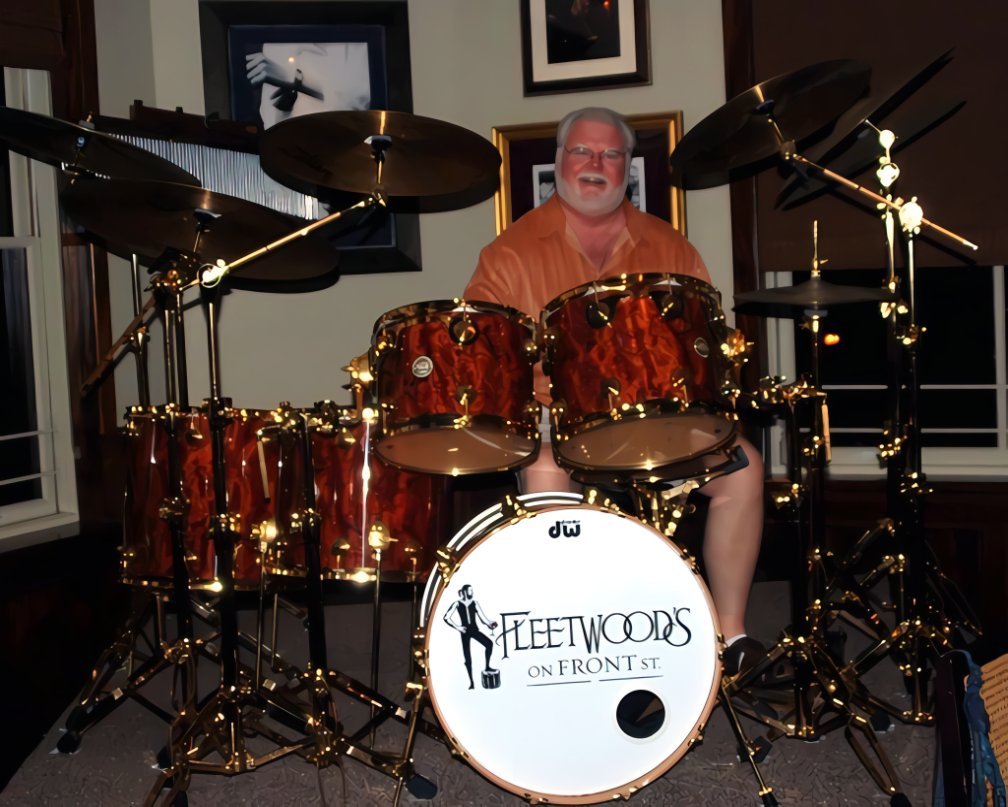
*Gary Ramsey (who took Jerns’ place as the Unusuals’ drummer in early 1966) participated in the second-generation Unusuals with Laurie Vitt and Terry Allan. Eventually, Ramsey left the northwest to return to his home state of Nevada. He remained there until his retirement years, making his living dealing cards at casinos in Las Vegas. Ramsey has recently moved to Louisiana.


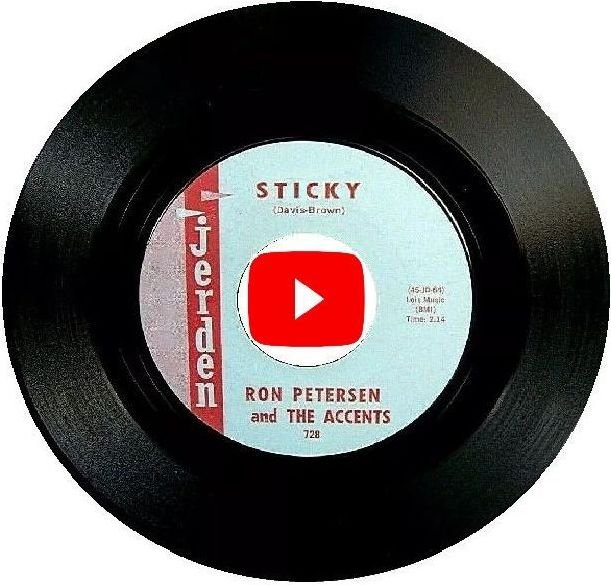




September 28, 2024 at QZVX
Jim Marquand says:
Great post Steve! I went to school with Laurie Vitt. I was working for the university recording speakers at events and recorded Timothy Leary speaking in the Viking Union building. Went to the Jefferson Airplane concert and took some great photos of the band.
September 28, 2024 at QZVX
Steven Smith says:
Thanks Jim. I know your name, I guess because we’re both oldtime Bellingham residents….unless maybe you had a tie in with radio or IGM?
September 27, 2024 at QZVX
Mike Matheson says:
Great article, I knew Vic Bundy from church camp, he inspired me to play. I played in many whatcom county bands including SPQR, and later others in Seattle area with Doug Ash.
September 27, 2024 at QZVX
Steven Smith says:
Glad you enjoyed it, Mike. Lots of history and nostalgia there. It took me a couple years to get it all together. I kept finding more obscure memorabilia.
September 27, 2024 at QZVX
Darlene says:
In all the articles read about the Unusuals I never see mentioned the names of the later band members – I know pod Bill Capp and Mick Murray, maybe, Vitt also.
September 27, 2024 at QZVX
Steven Smith says:
Darlene…All of those individuals you referenced are mentioned in this detailed history of the Unusuals. Getting near the bottom, just above the Epilogue read the section with the headline “Later Generation Unusuals (Fall 1967 – Late 1970”). It elaborates on the hybrids. There were three generations of the Unusuals. The first was the classic lineup that was hot on the regional teen dance circuit and cut the records (1965-1967): Vitt, Bundy, McDonald, Capp, Redmond and Jerns (replaced on drums by Gary Ramsey in early 1966, Gary played drums on Summer is Over). The second and third generation Unusuals were local bar bands that played mainly Whatcom County venues such as Iron Bull, Up&Up Tavern and the Reef in Point Roberts. That first hybrid band consisted of Vitt, Ramsey and Terry Allan. The third generation was Vitt, Capp, Mick Murray and Rob Rideout. They are all here. If you go back to check it out you will find that there is a nice vintage color photo of Vitt, Capp, Rideout and Murray in the third generation Unusuals…shortly before Vitt moved away and the band dissolved. Rob Rideout told me that in the end what had been the third generation Unusuals turned into the band “David” and played the Iron Bull.
September 20, 2024 at QZVX
Jeffrey Boice says:
Thank you so much. Wonderful article. I’m trying to picture Whatcom County’s reaction to Ken Kesey and Allen Ginsberg showing up.
September 20, 2024 at QZVX
Steven Smith says:
Jeffrey…I was in high school in 1967. There was a riff between city fathers, town folk and Western. Student protests against the war, drug use, faculty labeled as radicals. I think many of the establishment leaders did not know much about Ginsberg and Kesey but they knew they did not like anyone espousing free love, drugs, anti Vietnam war sentiments. Turbulent times. It really hit the fan when Western students shutdown the I-5 freeway during a protest.
September 19, 2024 at QZVX
Tom Cline says:
Great job Steven. Oh the memories.
September 20, 2024 at QZVX
Steven Smith says:
Tom…glad you enjoyed it. This was the culmination of a couple years of research and collaboration with Laurie Vitt, Pat Jerns, Kirk Wilde, Jay Hamilton and Rob Rideout. Kirk has since passed but it was great to have been in contact with him for about ten years.